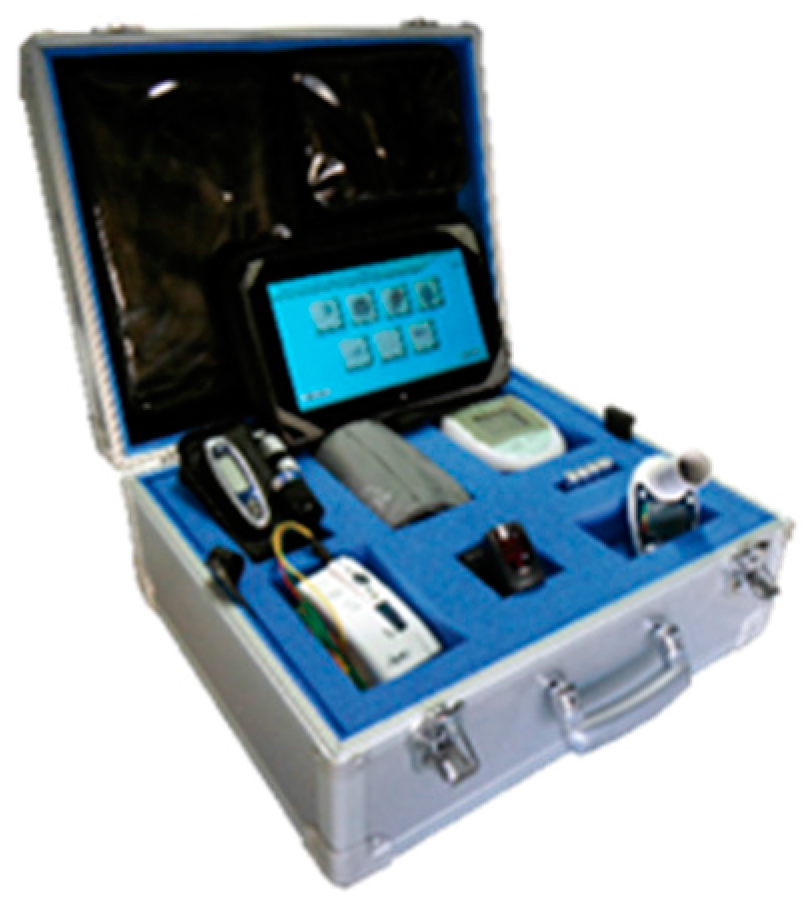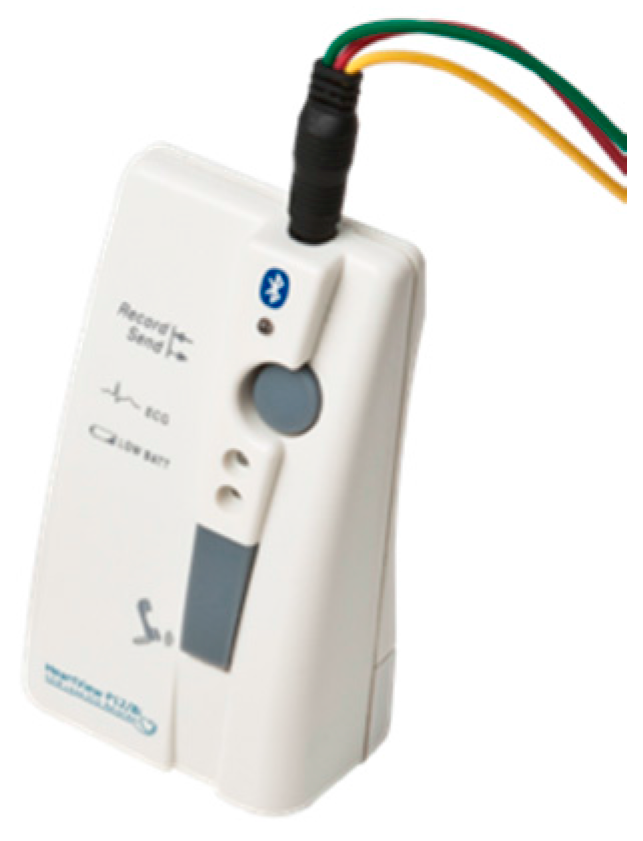Usefulness of a Telemedicine Program in Refractory Older Congestive Heart Failure Patients
Abstract
:1. Introduction
2. Materials and Methods
3. Statistical Analysis
4. Results
5. Discussion
6. Limitations of the Study
Author Contributions
Conflicts of Interest
References
- Scarborough, P.; Bhatnagar, P.; Wickramasinghe, K.; Smolina, K.; Mitchell, C.; Rayner, M. Coronary Heart Disease Statistics, 2010 ed.; British Heart Foundation: London, UK, 2010. [Google Scholar]
- Stewart, S.; Jenkin, A.; Buchan, S.; McGuire, A.; Capewell, S.; McMurray, J.J. The current cost of heart failure to the National Service in the UK. Eur. J. Heart Fail. 2002, 4, 361–371. [Google Scholar] [CrossRef]
- Riley, J.P.; Cowie, M.R. Telemonitoring in heart failure. Heart 2009, 95, 1964–1968. [Google Scholar] [CrossRef] [PubMed]
- Cleland, J.G.; Swedberg, K.; Follath, F.; Komajda, M.; Cohen-Solal, A.; Aguilar, J.C.; Dietz, R.; Gavazzi, A.; Hobbs, R.; Korewicki, J.; et al. The EuroHeart Failure survey programme—A survey on the quality of care among patients with heart failure in Europe. Part 1: Patient characteristics and diagnosis. Eur. Heart J. 2003, 24, 442–463. [Google Scholar] [CrossRef]
- Michalsen, A.; Konig, G.; Thimmew, W. Preventable causative factors leading to hospital admission with decompensation heart failure. Heart 1998, 80, 437–441. [Google Scholar] [CrossRef] [PubMed]
- Roccaforte, R.; Demers, C.; Baldassarre, F.; Teo, K.K.; Yusuf, S. Effectiveness of comprehensive disease management programmes in improving clinical outcomes in heart failure patients. A meta-analysis. Eur. J. Heart Fail. 2005, 7, 1133–1144. [Google Scholar] [CrossRef] [PubMed]
- Schwarz, K.A.; Mion, L.C.; Hudock, D.; Litman, G. Telemonitoring of heart failure patients and their caregivers: A pilot randomized controlled trial. Prog. Cardiovasc. Nurs. 2008, 23, 18–26. [Google Scholar] [CrossRef] [PubMed]
- Schmidt, S.; Schuchert, A.; Krieg, T.; Oeff, M. Home telemonitoring in patients with chronic heart failure: A chance to improve patient care? Dtsch. Arztebl. Int. 2010, 107, 131–138. [Google Scholar] [PubMed]
- Di Lenarda, A.; Scherillo, M.; Maggioni, A.P.; Acquarone, N.; Ambrosio, G.B.; Annicchiarico, M.; Bellis, P.; Bellotti, P.; De Maria, R.; Lavecchia, R.; et al. Current presentation and management of heart failure in cardiology and internal medicine hospital units: A tale of two worlds. The TEMISTOCLE study. Am. Heart J. 2003, 146, E12. [Google Scholar] [CrossRef]
- Hernandez, A.F.; Greiner, M.A.; Fonarow, G.C.; Hammill, B.G.; Heidenreich, P.A.; Yancy, C.W.; Peterson, E.D.; Curtis, L.H. Relationship between early physician follow-up and 30-day readmission among Medicare beneficiaries hospitalized for heart failure. JAMA 2010, 303, 1716–1722. [Google Scholar] [CrossRef] [PubMed]
- Di Tano, G.; De Maria, R.; Gonzini, L.; Aspromonte, N.; Di Lenarda, A.; Feola, M.; Marini, M.; Milli, M.; Misuraca, G.; Mortara, A.; et al. IN-HF Outcome Investigators. The 30-day metric in acute heart failure revisited: Data from IN-HF Outcome, an Italian nationwide cardiology registry. Eur. J. Heart Fail. 2015, 17, 1032–1041. [Google Scholar] [CrossRef] [PubMed]
- Sahn, D.J.; Demaria, A.; Kisslo, J.; Weyman, A. The committee on M mode standardisation of the American Society of Echocardiography: Recommendations regarding quantification in M-mode echocardiography: Results of a survey of echocardiographic measurements. Circulation 1978, 58, 1072–1083. [Google Scholar] [CrossRef] [PubMed]
- ATS Committee on Proficiency Standards for Clinical Pulmonary Function Laboratories. ATS Statement: Guidelines for the six-minute walk test. Am. J. Respir. Crit. Care Med. 2002, 166, 111–117. [Google Scholar]
- Mahoney, F.; Barthel, D. Functional evaluation: The Barthel Index. Md. State Med. J. 1965, 14, 61–65. [Google Scholar] [PubMed]
- Mortara, A.; Oliva, F.; Di Lenarda, A. Current perspectives in telemonitoring and devices in chronic heart failure patients: Lights and shadows. G. Ital. Cardiol. (Rome) 2010, 11, 33S–37S. [Google Scholar]
- Polisena, J.; Tran, K.; Cimon, K.; Hutton, B.; McGill, S.; Palmer, K.; Scott, R.E. Home telemonitoring for congestive heart failure: A systematic review and meta-analysis. J. Telemed. Telecare 2010, 16, 68–76. [Google Scholar] [CrossRef] [PubMed]
- Klersy, C.; De Silvestri, A.; Gabutti, G.; Regoli, F.; Auricchio, A. A meta-analysis of remote monitoring of heart failure patients. J. Am. Coll. Cardiol. 2009, 54, 1683–1694. [Google Scholar] [CrossRef] [PubMed]
- Clark, R.A.; Inglis, S.C.; McAlister, F.A.; Cleland, J.G.; Stewart, S. Telemonitoring or structured telephone support programmes for patients with chronic heart failure: Systematic review and meta-analysis. BMJ 2007, 334, 942. [Google Scholar] [CrossRef] [PubMed] [Green Version]
- Chaudhry, S.I.; Phillips, C.O.; Stewart, S.S.; Riegel, B.; Mattera, J.A.; Jerant, A.F.; Krumholz, H.M. Telemonitoring for patients with chronic heart failure: A systematic review. J. Card. Fail. 2007, 13, 56–62. [Google Scholar] [CrossRef] [PubMed]
- Seto, E. Cost comparison between telemonitoring and usual care of heart failure: A systematic review. Telemed. J. E-Health 2008, 14, 679–686. [Google Scholar] [CrossRef] [PubMed]
- Takeda, A.; Taylor, R.S.; Khan, F.; Krum, M.; Underwood, M. Clinical service organization for herat failure. Cochrane Database Syst. Rev. 2012. [Google Scholar] [CrossRef] [PubMed]
- Brunetti, N.D.; Scalvini, S.; Acquistapace, F.; Parati, G.; Volterrani, M.; Fedele, F.; Molinari, G. Telemedicine for cardiovascular disease continuum: A position paper from the Italian Society of Cardiology Working Group on Telecardiology and Infermatics. Int. J. Cardiol. 2015, 184, 452–458. [Google Scholar] [CrossRef] [PubMed]
- Feola, M. The prognostic value of different biomarkers in predicting clinical outcome in discharged heart failure patients. Minerva Cardioangiol. 2016, 64, 145–146. [Google Scholar] [PubMed]
- Knox, L.; Rahman, R.J.; Beedie, C. Quality of life in patients receiving telemedicine enhanced chronic heart failure disease management: A meta-analysis. J. Telemed. Telecare 2017, 23, 639–649. [Google Scholar] [CrossRef] [PubMed]
- Van Spall, H.G.C.; Rahman, T.; Mytton, O.; Ramasundarahettige, C.; Ibrahim, Q.; Kabali, C.; Coppens, M.; Haynes, R.B.; Connolly, S. Comparative effectiveness of transitional care services in patients discharged from the hospital with heart failure: A systematic review and network meta-analysis. Eur. J. Heart Fail. 2017, 11, 1427–1443. [Google Scholar] [CrossRef] [PubMed]
- Bashushur, R.L.; Shannon, G.W.; Smith, B.R. The empirical foundations of telemedicine intervention for chronic disease management. Telemed. J. E-Health 2014, 20, 769–800. [Google Scholar] [CrossRef] [PubMed]
- Ponikowski, P.; Voors, A.A.; Anker, S.D.; Bueno, H.; Cleland, J.G.; Coats, A.J.; Falk, V.; González-Juanatey, J.R.; Harjola, V.P.; Jankowska, E.A.; et al. 2016 ESC Guidelines for the diagnosis and treatment of acute and chronic heart failure. Eur. J. Heart Fail. 2016, 18, 891–970. [Google Scholar] [CrossRef] [PubMed]


| n = 48 | |
|---|---|
| Age | 80.4 ± 7.7 (range 53–93) |
| Males | 28 (58.3%) |
| Ischemic CMP | 15 |
| Valvular CMP | 14 |
| Other CMP | 19 |
| SR/AF | 20/28 |
| Creatinine (mg/dL) | 1.6 ± 0.6 |
| Haemoglobin (g/dL) | 11.7± 1.0 |
| Sodium (mEq/L) | 139.6 ± 2.9 |
| LVEF [%] in patients with preserved EF (EF ≥ 55%) (n = 11) | 58.9± 4.9 |
| LVEF [%] in patients with impaired EF (EF < 55%) (n = 37) | 33.2 ± 10.7 |
| NYHA at enrolment | 3.2 ± 0.8 |
| BNP at enrollment (pg/mL) | 1082.9 ± 1146.6 |
| 6MWT at enrollment (m) (n = 14) | 248.6 ± 88.4 |
| Barthel Index at enrolment | 77.9 ± 23.7 |
| Alarm parameters (%) (n = 44) | 43 |
| 24 h Ambulatory visit (%) (n = 44) | 18 |
| ED visit (%) (n = 44) | 11 |
| Hospital admission (%) (n = 44) | 18 |
| Cardiovascular death (n = 44) | 13 (29.5%) |
| Lost at FU | 4 (8.3%) |
| Costs (€/Year) | ED Admissions (n°/Year) | 30-Day Readmission (n°) | |
|---|---|---|---|
| Before Telemedicine enrolment | 116.856 | 21 (47.7%) | 35 (21.3%) |
| After Telemedicine enrollment | 40.065 | 5 (11.4%) | 12 (6.2%) |
| Satisfaction Questionnaire | (n° of Patients) |
|---|---|
| How to assess the number of visits received at home? | 0–40% (4) |
| 40–80% (23) | |
| 80–100% (0) | |
| What is the possibility of carrying out checks at home instead of in hospital? | 0–40% (0) |
| 40–80% (10) | |
| 80–100% (17) | |
| Do you prefer to carry out checks at home instead of in hospital? | 0–40% (1) |
| 40–80% (11) | |
| 80–100% (15) | |
| Is the presence of a nurse at home helpful? | 0–40% (0) |
| 40–80% (7) | |
| 80–100% (20) | |
| Were caregivers satisfied with the visit at home instead of in hospital? | 0–40% (0) |
| 40–80% (20) | |
| 80–100% (7) | |
| Have additional check-ups required by the doctor been helpful? | 0–40% (0) |
| 40–80% (21) | |
| 80–100% (6) | |
| Would you recommend to a friend, if needed, this telemedicine service? | 0–40% (0) |
| 40–80% (7) | |
| 80–100% (20) |
© 2018 by the authors. Licensee MDPI, Basel, Switzerland. This article is an open access article distributed under the terms and conditions of the Creative Commons Attribution (CC BY) license (http://creativecommons.org/licenses/by/4.0/).
Share and Cite
Burdese, E.; Testa, M.; Raucci, P.; Ferreri, C.; Giovannini, G.; Lombardo, E.; Avogadri, E.; Feola, M. Usefulness of a Telemedicine Program in Refractory Older Congestive Heart Failure Patients. Diseases 2018, 6, 10. https://doi.org/10.3390/diseases6010010
Burdese E, Testa M, Raucci P, Ferreri C, Giovannini G, Lombardo E, Avogadri E, Feola M. Usefulness of a Telemedicine Program in Refractory Older Congestive Heart Failure Patients. Diseases. 2018; 6(1):10. https://doi.org/10.3390/diseases6010010
Chicago/Turabian StyleBurdese, Emanuela, Marzia Testa, Pasquale Raucci, Cinzia Ferreri, Gabriele Giovannini, Enrico Lombardo, Enrico Avogadri, and Mauro Feola. 2018. "Usefulness of a Telemedicine Program in Refractory Older Congestive Heart Failure Patients" Diseases 6, no. 1: 10. https://doi.org/10.3390/diseases6010010





